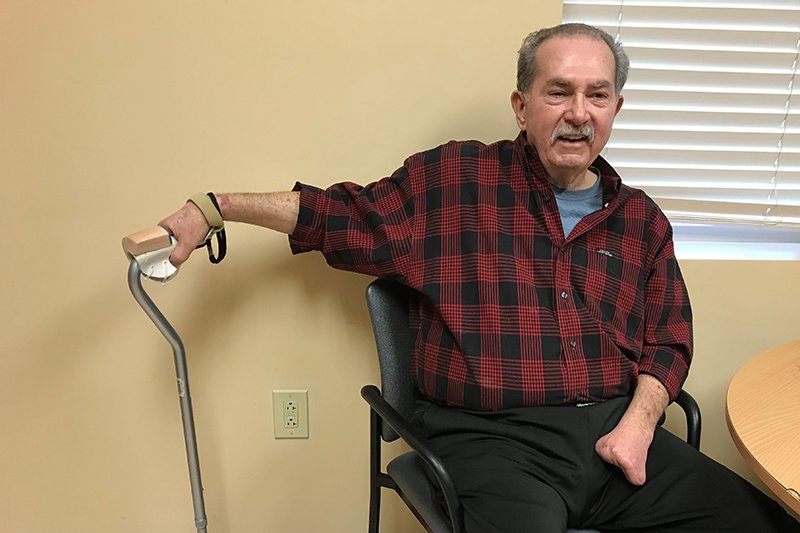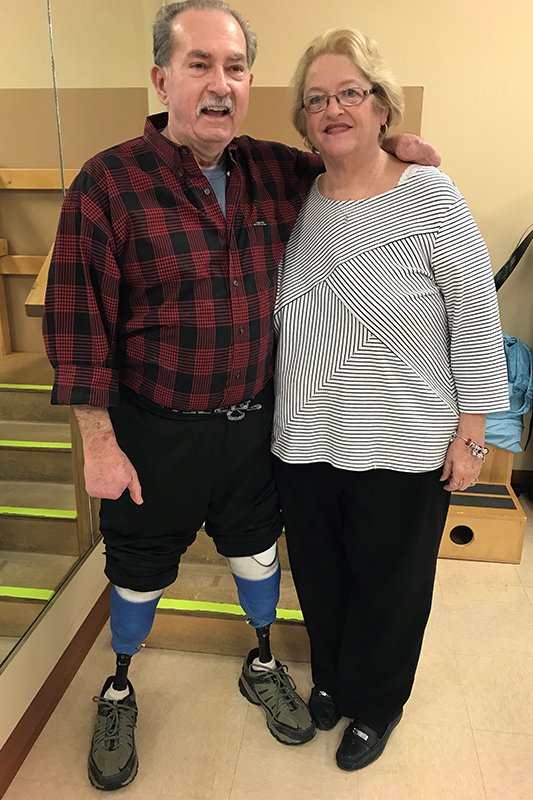Overcoming the Insurmountable: Michael's Story

Imagine thinking you have indigestion and then losing both lower legs and all but one finger. Your journey includes surgery that lengthens from six hours at first to a total of thirteen, then one month unconscious and fully four months in the hospital. From there you must learn how to move without legs and try to do everyday tasks without fingers. It really is unimaginable, except that all of this and more really happened to Michael Turner.
Michael Turner’s “indigestion” was really caused by heart valve disease and extensive artery blockages. He was fortunate to be diagnosed quickly and have life-saving surgery at Moses Cone Hospital, but the severity of his situation caused cardiogenic shock. In that case, his blood pressure was too low to provide blood to his brain, lungs, kidneys and other vital organs, putting his life very much on the line. Fortunately, there are medications that can remedy this and save a life, but sometimes at a secondary cost. Those medications shunt life-saving blood to vital organs in part by limiting blood flow to the limbs, which, in Michael’s case, led to the loss of his legs and fingers.
Michael is alive today thanks to amazing work by his heart surgeons and ICU team. At the same time, to use the words of his cardiologist James Hochrein, MD, “he was left with disabilities that I think would be insurmountable for a lesser man.” If you ask Michael, he’ll tell you the key to his story is fairly simple: “I’m just one of those crazy people: If something happens, you just make the best of it. I had things I wanted to do!”
And make the best of it he has. Some would call his recovery and rehab grueling. Early on at Select Specialty Hospital within Moses Cone Hospital, and continuing at Cone Inpatient Rehabilitation, he learned to use a wooden board to slide from his wheelchair to a commode, a bed, or a car. Michael despised that wheelchair, but he had to use it to get around until his legs healed enough for him to be fitted with prostheses.
Michael thought that he’d get his prosthetic legs one day and start walking the next. He found out that transition was not going to be quick and easy, any more than what he’d already been through. He sought help at Cone Outpatient Neurorehabilitation Center, which he chose because the physical therapist Robin Waldron had been highly recommended to him. In fact, he chose to drive all the way from his home in Virginia for his therapy sessions, both physical and occupational.

Michael taking control of his new legs
At first Michael needed a walker to get around on his prostheses, but progressed to using just a cane. Of course even that was a challenge: How do you grab a cane handle without any fingers? His occupational therapist, Karen Pulaski, came up with a custom handle design and his prosthetist Steven modified it to make it work for his unique situation. Now he calls the cane his “security stick,” and uses it just some of the time.
These days Michael not only walks on his new legs, he does all of his own dressing, grooming and even light cooking for himself. He came up with a lot of solutions to problems, working side by side with his OT to develop custom tools that enabled him to eat, write, use a hand-held shower and manage personal care in the bathroom. He jumped hundreds of hurdles to get to this place, and each hurdle passed was wonderful, says his wife Alice, who adds, “When you start out, you can’t see where the end is, the possibility of it.” Michael credits the rehab crew with bringing him along, giving him a new challenge each and every time he came in for his physical and occupational therapy over 16 weeks’ time.
He really impressed the cardiac surgeon who was part of his lifesaving team, Clarence Owen, MD, who says this about him: “Michael is one of a kind. He walked into my office for his 1 year follow up appointment on his own, without any assistance. His story is truly remarkable. Early on it was questionable whether he would even survive, and for him to fight through the recovery with such determination and positive attitude was inspiring to everyone who ever interacted with him.” Dr. Owen also acknowledges that Michael didn’t do this alone. He says, “Michael’s family was equally determined, at his bedside throughout his entire ordeal, and an incredible source of support for Michael and all of his caregivers. Their positive attitude, encouragement and emotional support was inspiring and very important for Michael and his successful journey.”
Still, all these months later, Michael’s not done with his recovery. He’ll be doing more occupational therapy once he gets a mechanical prosthesis for his right arm (the one that still has a thumb) and an electric one for the left. With the help of his very supportive wife, three children and seven grandchildren, he’s up for the challenge. After all, he’s got things he wants to do!